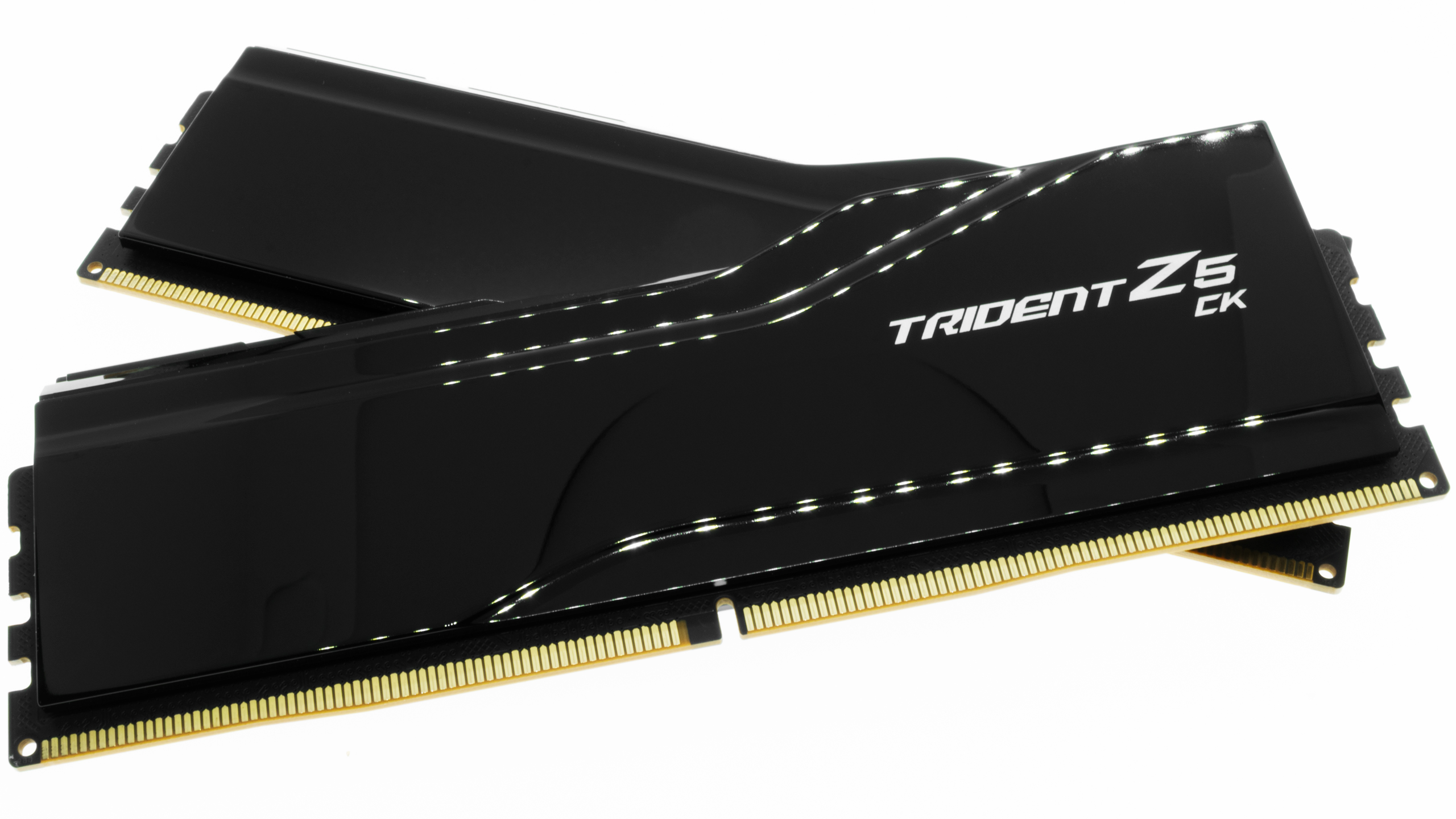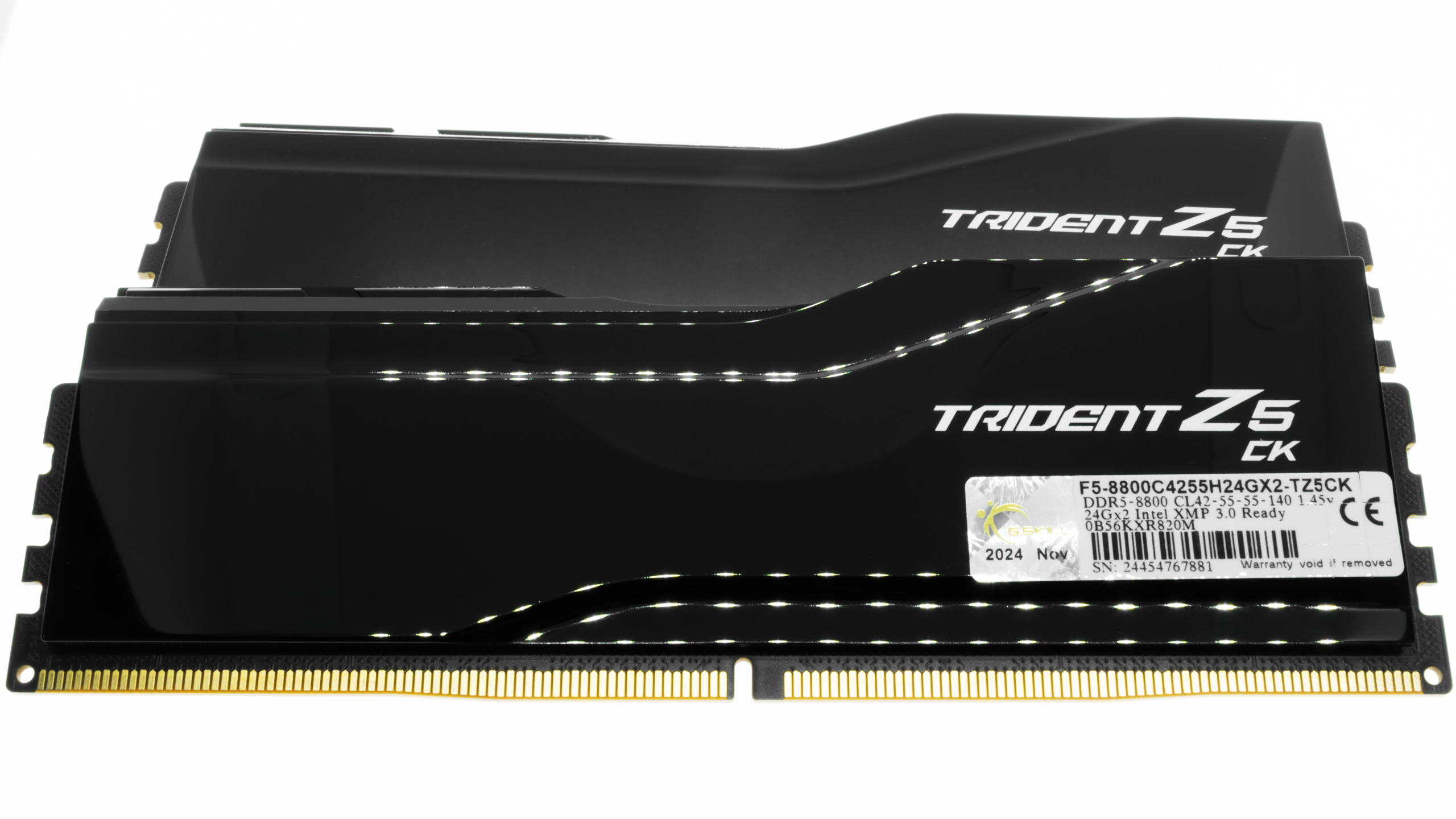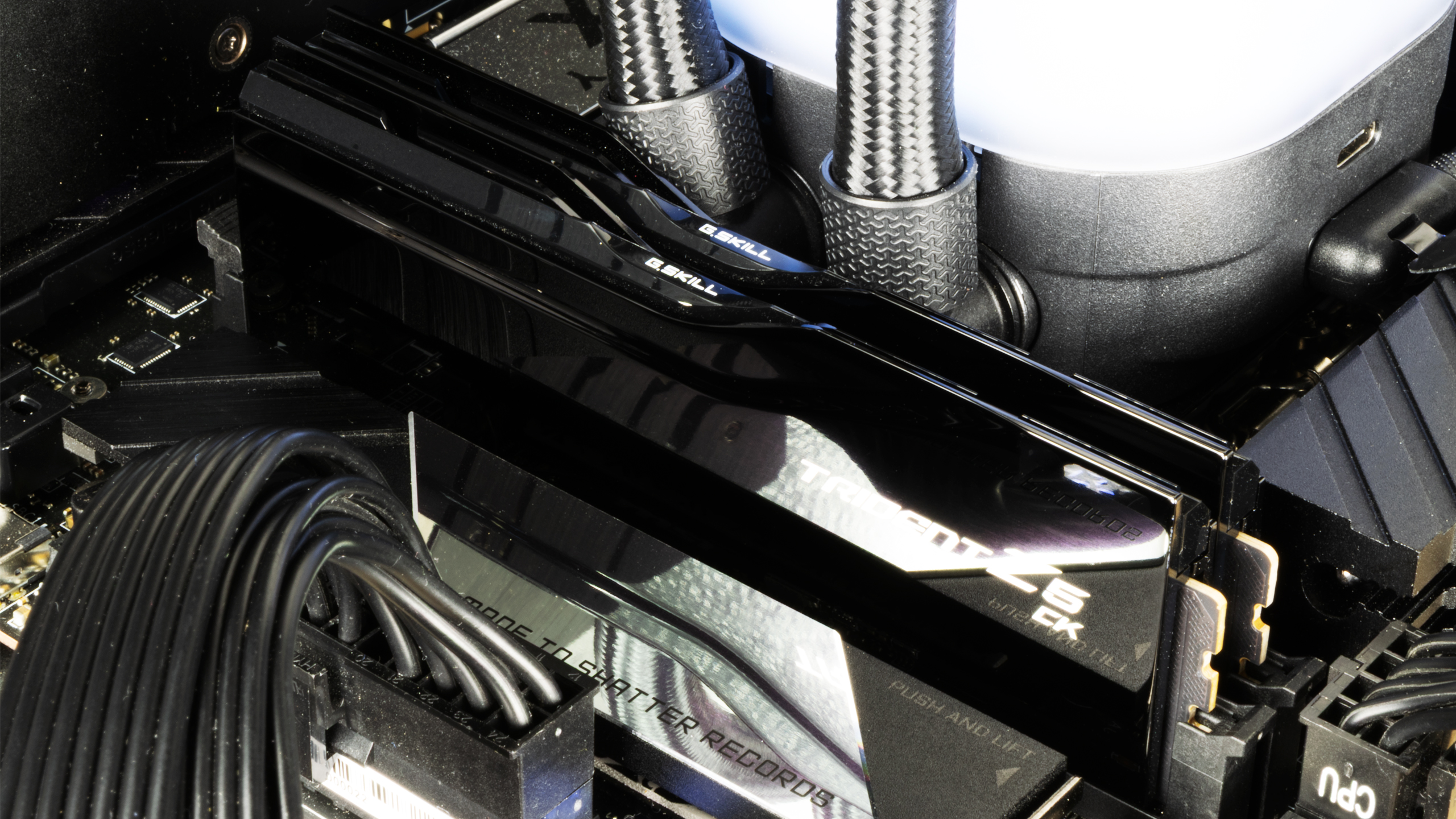Like the numerous other Trident Z5 memory modules, the CK variant still stands at 1.65 inches (42mm) tall. G.Skill offers both regular and RGB versions of the Trident Z5 CK memory. Whether you prefer the RGB flair or not, the heights of both variants remain the same. Only black is available, but we’re not complaining, as the memory modules look stunning in piano black.
Image 1 of 3
(Image credit: Tom’s Hardware)
(Image credit: Tom’s Hardware)
(Image credit: Tom’s Hardware)
All Trident Z5 CK memory modules are equipped with a black PCB. This 48GB memory kit comprises two 24GB modules designed with a single-rank configuration. It features eight SK hynix H5CGD8MGBDX021 (M-die) ICs arranged in a single-sided layout, each with a capacity of 3GB. The power management IC (PMIC) is the Richtek 0P=BA CG3, while the client clock driver is the Rambus DR5CKD1GC0.
It is important to note that AMD’s current 800-series platform does not fully support CUDIMMs. They will operate, albeit in bypass mode, which results in the loss of the CKD functionality.
Tailored for Intel’s Core Ultra 200S processors (codenamed Arrow Lake) and the latest 800-series platform, the Trident Z5 CK memory modules default to DDR5-6400, the native data rate supported by Arrow Lake. The timings are set at 52-51-51-102. This kit is designed specifically for Intel chips, so it only features XMP 3.0. The primary profile is optimized for rated DDR5-8800 at 42-55-55-104 timings with 1.45V DRAM voltage. In contrast, the backup profile caters to DDR5-6400 at 32-39-39-102 timings, operating with a 1.35V DRAM voltage. See our PC Memory 101 feature and How to Shop for RAM story for more timings and frequency considerations.
Comparison Hardware Swipe to scroll horizontally
Memory Kit
Part Number
Capacity
Data Rate
Primary Timings
Voltage
Warranty
G.Skill Trident Z5 CK
F5-8800C4255H24GX2-TZ5CK
2 x 24GB
DDR5-8800 (XMP)
42-55-55-140 (2T)
1.45
Lifetime
Corsair Vengeance RGB CUDIMM
CMHC48GX5M2X8400C40
2 x 24GB
DDR5-8400 (XMP)
40-52-52-135 (2T)
1.40
Lifetime
TeamGroup T-Force Xtreem
FFPD548G7200HC34ADC01
2 x 24GB
DDR5-7200 (XMP)
34-42-42-84 (2T)
1.40
Lifetime
G.Skill Trident Z5 RGB
F5-7200J3646F24GX2-TZ5RK
2 x 24GB
DDR5-7200 (XMP)
36-46-46-115 (2T)
1.35
Lifetime
Corsair Dominator Titanium First Edition
CMP48GX5M2X7200C36FEW
2 x 24GB
DDR5-7200 (XMP)
36-46-46-116 (2T)
1.40
Lifetime
Image 1 of 2
(Image credit: Tom’s Hardware)
(Image credit: Tom’s Hardware)
The Intel system comprises the Core Ultra 9 285K and the MSI MEG Z890 Unify-X (7E20v1A41 firmware). In contrast, the AMD system employs the Ryzen 9 9900X and MSI MPG X870E Carbon WiFi (7E49v1A23 firmware). The Corsair iCUE Link Titan 360 RX LCD CPU liquid cooler effectively maintains the operating temperatures of both the Arrow Lake and Zen 5 processors under optimal conditions.
The MSI GeForce RTX 4080 16GB Gaming X Trio addresses the more graphics-intensive workloads, ensuring that our gaming RAM benchmarks do not have a graphics bottleneck. TeamGroup’s A440 Lite PCIe 4.0 SSD balances performance and storage capacity, with 2TB of high-speed storage up to 7,400 MB/s for our Windows 11 24H2 installation, benchmarking software, and games.
Meanwhile, the Corsair RM1000x Shift ATX 3.0 power supply delivers a reliable and ample power source to our test systems, directly feeding the GeForce RTX 4080 with a native 16-pin (12VHPWR) power cable. Finally, the Streacom BC1 open-air test bench accommodates all of our hardware.
Swipe to scroll horizontally
Component
Intel System
AMD System
Processor
Intel Core Ultra 9 285K
AMD Ryzen 9 9900X
Motherboard
MSI MEG Z890 Unify-X
MSI MPG X870E Carbon WiFi
Graphics Card
MSI GeForce RTX 4080 16GB Gaming X Trio
MSI GeForce RTX 4080 16GB Gaming X Trio
Storage
TeamGroup A440 Lite 2TB
TeamGroup A440 Lite 2TB
Cooling
Corsair iCUE Link Titan 360 RX LCD
Corsair iCUE Link Titan 360 RX LCD
Power Supply
Corsair RM1000x Shift
Corsair RM1000x Shift
Case
Streacom BC1
Streacom BC1
Image 1 of 23
(Image credit: Tom’s Hardware)
(Image credit: Tom’s Hardware)
(Image credit: Tom’s Hardware)
(Image credit: Tom’s Hardware)
(Image credit: Tom’s Hardware)
(Image credit: Tom’s Hardware)
(Image credit: Tom’s Hardware)
(Image credit: Tom’s Hardware)
(Image credit: Tom’s Hardware)
(Image credit: Tom’s Hardware)
(Image credit: Tom’s Hardware)
(Image credit: Tom’s Hardware)
(Image credit: Tom’s Hardware)
(Image credit: Tom’s Hardware)
(Image credit: Tom’s Hardware)
(Image credit: Tom’s Hardware)
(Image credit: Tom’s Hardware)
(Image credit: Tom’s Hardware)
(Image credit: Tom’s Hardware)
(Image credit: Tom’s Hardware)
(Image credit: Tom’s Hardware)
(Image credit: Tom’s Hardware)
(Image credit: Tom’s Hardware)
The Trident Z5 CK DDR5-8800 memory kit showcased solid performance, ranking below the Xtreem DDR5-7200 C34. Regarding gaming, G.Skill’s memory kit performed comparably to Corsair’s DDR5-8400 C40.
During the bandwidth test, the Trident Z5 CK stood out by surpassing all competitors with a peak of 84.30 GB/s. Additionally, it achieved the highest score in the V-Ray 6 benchmark.
Regrettably, DDR5-8800 exceeds the limitations of our Ryzen 9 9900X sample. The integrated memory controller (IMC) of the 12-core Zen 5 processor cannot accommodate memory of this speed. Consequently, our system would not post with DDR5-8800 memory. Unfortunately, AMD’s existing platform doesn’t fully leverage CUDIMMs’ potential.
Although we had better luck with the Ryzen 7 9700X sample, our system remained unstable and frequently encountered BSOD errors. Due to the extent of the system instability, the Ryzen 7 9700X could not satisfactorily complete our benchmarking tests.
Overclocking and Latency Tuning Image 1 of 3
(Image credit: Tom’s Hardware)
(Image credit: Tom’s Hardware)
(Image credit: Tom’s Hardware)
It goes without saying that SK hynix M-die ICs are among the easiest ICs to overclock. A slight increase in voltage can go a long way on these ICs. Sometimes, the memory functions perfectly with the exact timings, as seen with the Trident Z5 CK DDR5-8800 C42 memory kit.
The memory kit operates at 1.45V for DDR5-8800. Consequently, we elevated it to 1.5V. This additional voltage gave us the headroom to run the memory stably at DDR5-9200 with the same 42-55-55-140 timings as DDR5-8800.
Lowest Stable Timings Swipe to scroll horizontally
Memory Kit
DDR5-7200 (1.45V)
DDR5-7200 (1.5V)
DDR5-7600 (1.45V)
DDR5-7800 (1.45V)
DDR5-8800 (1.45V)
DDR5-9200 (1.50V)
G.Skill Trident Z5 CK DDR5-8800 C42
N/A
40-52-52-134 (2T)
N/A
N/A
N/A
42-55-55-140 (2T)
Corsair Vengeance RGB CUDIMM DDR5-8400 C40
38-50-50-128 (2T)
N/A
N/A
N/A
40-52-52-135 (2T)
N/A
Corsair Dominator Titanium First Edition DDR5-7200 C36
34-42-42-82 (2T)
N/A
N/A
36-46-46-116 (2T)
N/A
N/A
TeamGroup T-Force Xtreem DDR5-7200 C34
N/A
N/A
36-46-46-86 (2T)
N/A
N/A
N/A
G.Skill Trident Z5 RGB DDR5-7200 C36
34-42-42-84 (2T)
N/A
36-46-46-115 (2T)
N/A
N/A
N/A
SK hynix M-die ICs can occasionally be a little stubborn with tight timings. However, by increasing the DRAM voltage to 1.5V on the Trident Z5 CK, we successfully lowered the timings from 42-55-55-140 to 40-52-52-134!
There might be a bit more leeway on the memory modules, but that would involve running the memory above 1.5V, and we generally suggest avoiding that for long-term use.
Bottom Line The G.Skill Trident Z5 CK DDR5-8800 C42 ranks among the top tier of performance DDR5 memory. It boasts aesthetics that can impress anyone and performance that your system cannot complain about. Unfortunately, one significant limitation lies outside G.Skill’s control. Intel’s Core Ultra 200S is currently the only consumer chip to support CUDIMMs and has the highest possibility of playing nice with this memory kit, leaving AMD fans out in the cold. However, that doesn’t mean you can’t use this memory kit on an AMD platform; the DIMMs can run in bypass mode. They just require an AMD chip with an exceptional IMC to hit top speeds, which is not easy to find unless you have access to multiple samples.
Naturally, the G.Skill Trident Z5 CK DDR5-8800 C42 comes with a hefty price tag of $319.99 , likely more than most regular users would consider spending on RAM. The CUDIMMs came out recently, leading to an early adopter premium similar to the initial launch of DDR5. Therefore, we don’t anticipate a drop in the price of G.Skill’s memory kit anytime soon. If you’re determined to get DDR5-8800 memory with a 48GB capacity, the G.Skill Trident Z5 CK DDR5-8800 C42 is an excellent choice that you shouldn’t overlook.











